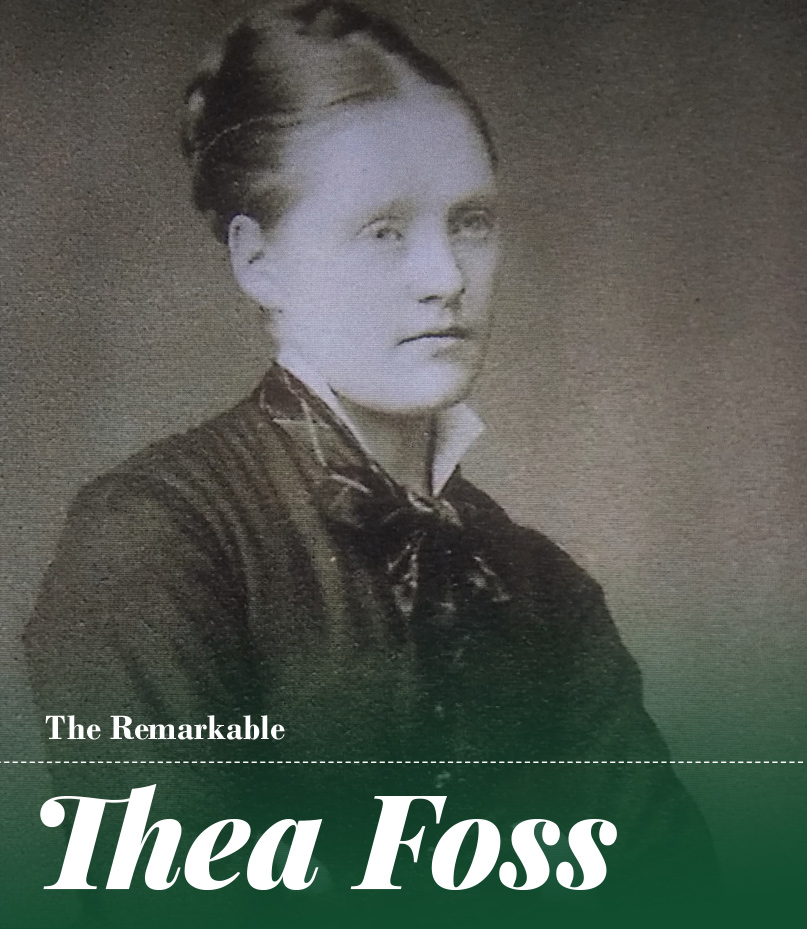
 Stepping off the train in April 1889 into the hustle-bustle town of lumber mills, fishing boats, and coal schooners, Thea Christiansen Foss would have seemed an unlikely candidate to become the founder of the largest tug and tow company on the West Coast. She arrived in Tacoma, Washington, with an infant daughter in her arms and two young sons in tow. Whatever English language the Norwegian-born woman knew, she learned on the train from Minnesota, her great-granddaughter Shannon Bauhofer shared.
Stepping off the train in April 1889 into the hustle-bustle town of lumber mills, fishing boats, and coal schooners, Thea Christiansen Foss would have seemed an unlikely candidate to become the founder of the largest tug and tow company on the West Coast. She arrived in Tacoma, Washington, with an infant daughter in her arms and two young sons in tow. Whatever English language the Norwegian-born woman knew, she learned on the train from Minnesota, her great-granddaughter Shannon Bauhofer shared.
Photos from the period show Foss as a young, elegant woman—her hair pulled back in a bun or braids; her buttoned, high-collared dresses adorned with a brooch. She was soft-spoken and reserved, Bauhofer said—the polar opposite of the character that would be portrayed by Marie Dressler in the 1933 film Tugboat Annie, which was inspired by Foss’s life. “She was unique on the waterfront,” Bauhofer said of her great-grandmother. Through strength of character and being in the right place at the right time, Thea Foss soon launched one of the state’s oldest brands, Foss Launch & Tug. Today the company is known as Foss Maritime, but the culture that Thea Foss established still influences the company today.
The Foss name “is synonymous with Puget Sound and has been for years,” said historian Mike Skalley, a Foss retiree who wrote three histories on the company. “The company has had – and continues to have — such an important impact on the region’s economy.” Terri Bates, manager of the M/V Thea Foss, a historic yacht owned by Foss Maritime’s parent company, Saltchuk, added, “What I love about the Foss company is its rich old history in Seattle. It’s a cool, iconic brand.” The story of the founder is as remarkable as the company that bears her surname.
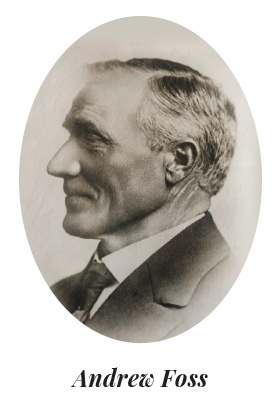 Thea and Andrew Foss came to Tacoma, by way of Minnesota, in search of economic opportunity and a climate that would better suit Andrew, who had asthma. Andrew, who had been a furniture maker in Minneapolis, went west first to work in construction in Tacoma. Thea and their three children – toddlers Arthur and Wedell and baby Lillian – joined him in April 1889. They settled into a float house Andrew built on the waterfront below 12th Street. Son Henry would be born in Tacoma in 1891.
Thea and Andrew Foss came to Tacoma, by way of Minnesota, in search of economic opportunity and a climate that would better suit Andrew, who had asthma. Andrew, who had been a furniture maker in Minneapolis, went west first to work in construction in Tacoma. Thea and their three children – toddlers Arthur and Wedell and baby Lillian – joined him in April 1889. They settled into a float house Andrew built on the waterfront below 12th Street. Son Henry would be born in Tacoma in 1891.
The Fosses found a lot of similarities to the land of their birth—forests and fjords, maritime and mountains—and other Norwegians who had made their way to Tacoma because of opportunities to work in fishing, logging, and farming.
The presence of people from her native land was likely welcoming for young Thea, but it was not an easy transition. Historian Lane Morgan described Thea’s new home as “constructed from scrap lumber on salvaged logs [Andrew] found floating on the waterway…Under her feet the whole room moved.” It was reportedly “about the size of a boxcar,” but was appointed with wood and leather-upholstered furniture, an oil lamp, a pot belly stove, a closet, and a new bed.
Thea had a fear of water “exacerbated by the allure it held for her toddlers,” Morgan wrote. And soon after settling into her new home on the water, she contracted typhoid pneumonia and was bedridden for more than two months (typhoid was fatal in 10% of cases in the late 1800s, according to the National Institutes of Health). When Thea recovered, Andrew left for two months to work on building a house in Purdy. Her strength of character during this time cannot be underestimated.
“I think, one, she’s Norwegian,” Bauhofer said, referring to the fortitude of those who survived the immigrant experience. “She was willing to leave Norway for Minnesota. Then, her husband left to look for better economic opportunity and a better climate in the west. She was pregnant and stayed behind in Minnesota through the winter. When she took a train to join him, she didn’t speak English and picked up some of the language along the way.”
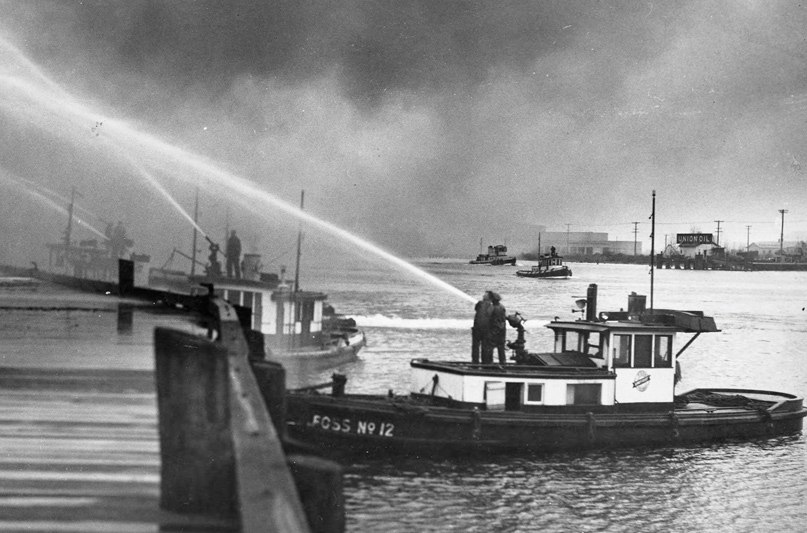
But their move to Tacoma was fortuitous: Washington was a new state and Tacoma – with its deep-water harbor and new transcontinental railroad link — was an emerging center of international trade. Tacoma’s population grew from 1,098 to 36,006 in 10 years. In Thea’s lifetime here, the population would grow to 106,000. Bauhofer said of her great-grandparents’ good fortune in arriving in Puget Sound when they did: “Tacoma was the gateway to the Pacific and the gateway to the East Coast. Crew members needed a way to get back and forth and, later, logs needed to be moved. They saw a need and they filled that need.”
Commencement Bay was Thea‘s front yard, and the traffic outside her home consisted of fishing boats and schooners arriving to take on loads of lumber, coal, or wheat. To help support her young family while her husband was working in Purdy, she bought a rowboat for $5 from a fisherman, fixed it up, and sold it. She painted it green and white, the colors used by Foss Maritime today. With her profits, she bought another rowboat and made it available for rent. With the proceeds, she bought yet another boat, and then another.
When he returned home, Andrew found his wife’s venture to be more lucrative than carpentry, so he put his woodworking skills into building rowboats and launches. Their float home became the base of operations for Foss Boathouse, with rowboats and launches for hire 24/7. There are about nine boats are visible in an 1890 photo of the boathouse. The Fosses also established a small dry goods store in the boathouse.
The Fosses’ fledgling fleet delivered goods to the ships anchored in the bay and carried mariners between ship and shore. They added tow bitts to their launches, expanded into towing, and were awarded contracts to haul lumber. As Tacoma grew, so did the Fosses’ company. According to a Foss Maritime history, “By 1904 the company boasted 10 launches, a shipyard, a 60-passenger oil-powered boat, and a small rescue craft to help disabled vessels.”
Amid the comings and goings on the waterfront, the boathouse might have seemed homelike for mariners who stopped in to buy staple goods. Thea “always had a pot of coffee brewing,” Bauhofer said. A visitor might chat with Peter or Iver – Andrew’s boat-builder brothers – about the latest launch under construction, or watch the Fosses’ three sons bail water and clean the boats. Depending on the time of day, the visitor might smell dinner being prepared by Thea in her kitchen.
In addition to managing the company’s finances and raising four children, Thea regularly cooked dinner for her employees. “She treated them like family,” Bauhofer said, “and on weekends, members of the waterfront community would gather at the boathouse for meals.”
The company became Foss Launch Co. in 1908. Foss launches became a vital part of the local transportation network, as attested to by reports in the Tacoma Times newspaper. The company regularly ran a four-line ad that read: “Avoid the rush. Launches every few minutes. Foss Launch Co., Commercial Bridge.” Foss launches took residents to see the USS Tacoma when the cruiser visited its namesake city in April 1904, as well as to community events such as games of the Tacoma Columbias amateur baseball team, Tacoma High School class reunions, dances at Three Tree Point, and a masquerade ball at the Bay View Pavilion.
It was a competitive business, with several launch operators trying to attract passengers to their docks on the waterfront. When the USS Tacoma visited, Foss’s agent was so good at selling tickets that passengers, perhaps so excited by the prospect of visiting a Navy warship, didn’t pay attention to which vessel they bought passage on. Many passengers back in the day used Foss tickets to board Kirby & Alger’s launches from the Northwestern dock near the 11th Street bridge. Rather than “starting a row,” the Tacoma Times reported, Kirby & Alger first accepted the tickets but “soon tired of carrying passengers to the cruiser on Foss tickets and getting nothing out of it,” the Times reported.
Thea and Andrew’s daughter, Lillian, died in 1914 at age 25 from tuberculosis. Thea, who had been her daughter’s caregiver, “was devastated and reduced her role in the company,” Bauhofer said. The Fosses’ sons – Arthur, 29; Wedell, 27; and Henry, 23 – stepped in to help their father run the company.
The Great War years and the ensuing Roaring ’20s were years of significant growth for the company. “The port was expanding like crazy,” historian Skalley said. “Andrew realized he had to expand or other tug companies would take over.” In 1916, Foss purchased its first tug, a five-year-old, 37-footer renamed Foss 9, and the company became Foss Launch & Tug.
In 1917, activity at Foss Launch & Tug was frequently reported on by The Tacoma Times. On May 24, the newspaper reported that the Grays Harbor Construction Co.’s tug Hunter “left this morning for Tacoma with two of its largest scows, which were bought Wednesday by Arthur Foss of Tacoma for the Foss Launch Co.” On June 4, a large section of drydock for Todd Shipyards was placed in position “with the aid of launches from the Foss Launch Co. This is the first of four sections of the immense drydock to be used at the shipbuilding plant.”
On Nov. 1, the Times reported Foss bought the Tacoma Tugboat Co., adding to the Foss fleet “the steam tugs Olympic, Echo, Elf and the gas tug Ohio, as well as 12 barges. The Foss company is now the largest of its kind on the Sound.” On Nov. 5, the Times reported that the “speedy action” of Foss employees prevented the “spread of a serious fire which started aboard the tug Daphne, docked directly beneath the Foss company buildings….Fire extinguishers and streams from Foss No. 12, the fire boat, soon had the blaze under control.”
Foss purchased the assets of Rouse Towing in 1922 and opened an office in Seattle, Skalley said. “Also in the 1920s, an office was opened in Port Angeles with some tugs assigned there,” he said. “The Seattle and Tacoma offices operated independently of each other, each having its own fleet of tugs and barges and management. The Seattle division was incorporated as ‘Foss Company,’ with the Tacoma division remaining Foss Launch & Tug Co. Sons Arthur and Wedell ran the Seattle division, Henry the Tacoma division.”
When Thea died on June 7, 1927, the day before her 70th birthday, the company she founded 38 years earlier had 29 tugs and launches and was, Foss Maritime historian Bruce Sherman wrote, “the leading tugboat operator on Puget Sound.”
Andrew Foss died in 1937 at 82 and his sons continued to operate the company. During World War II, the Foss Company — the Fosses’ Seattle division — became part of Foss Launch & Tug.
Foss tugs were second to the U.S. Navy in building naval installations in the South Pacific. One tug, the Justine Foss — named for one of Wedell’s daughters was captured by Japanese forces Dec. 23, 1941, on Wake Island. Crew member Drew Foss, one of Henry’s two children, spent the war years in a Japanese POW camp in Burma. He returned home aboard the USS Takanis Bay on Nov. 7, 1945. Post-war, Foss tugs supported various industries in Alaska’s North Slope, Los Angeles, San Francisco, and Puget Sound.
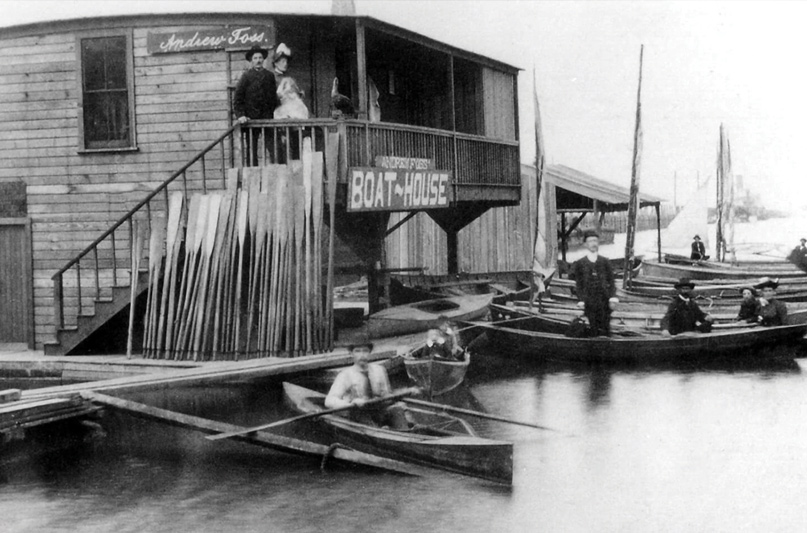
Wedell died in 1955, Arthur in 1964, and Henry retired from the company in 1966. Henry, his brothers’ heirs, and other shareholders of the company made the decision in 1969 to sell Foss Launch & Tug to the Dillingham Corporation of Honolulu, a transportation and construction company. “The Seattle office then became the headquarters for all of Foss Launch & Tug Co.,” Skalley said. “The other offices were still manned, but were primarily dispatch and crewing offices for the tugs assigned there.”
Dillingham added 14 new tugs and five used tugs to the Foss fleet in the 1970s. Dillingham sold Foss Launch & Tug in 1987 to Totem Resources (now Saltchuk). In 2013, Saltchuk consolidated its five tug and barge companies under the Foss banner, creating the nation’s largest coastal tug and barge fleet. Foss continues to operate autonomously, with headquarters and a shipyard in Seattle and home offices in four states. Foss provides harbor services and transportation operations in all major U.S. coastal ports.
Many of Thea Foss’s values remain part of the culture of the company.
From Thea Foss’s life:
- Treat employees like family.
- Give back. “The law imprinted in all men’s hearts is to love one another,” Foss wrote in her diary in 1907.
- Stand ready to serve when needed.
- Identify customers’ needs and meet them.
- Look for new opportunities.
From Foss’s mission statement:
- “Provide a work environment where all employees would feel safe and proud to have their sons and daughters employed.”
- “Provide the resources for employees to give back to their communities.”
- “’Always Safe, Always Ready’ represents the way we conduct business to meet the needs of customers.”
- “Maintain a steadfast focus on our customers’ needs and preferences in everything we do.”
- “Continue to extend and expand our operations globally.
Bauhofer is a granddaughter of Henry Foss (1891-1986), Andrew and Thea’s youngest. He attended Stanford University, was a tugboat captain for Foss Launch & Tug, was elected to the state Senate and the Tacoma Port Commission in the 1930s, and served as a naval intelligence officer during World War II. He retired from the Navy with the rank of rear admiral. Henry Foss High School in Tacoma is named for him.
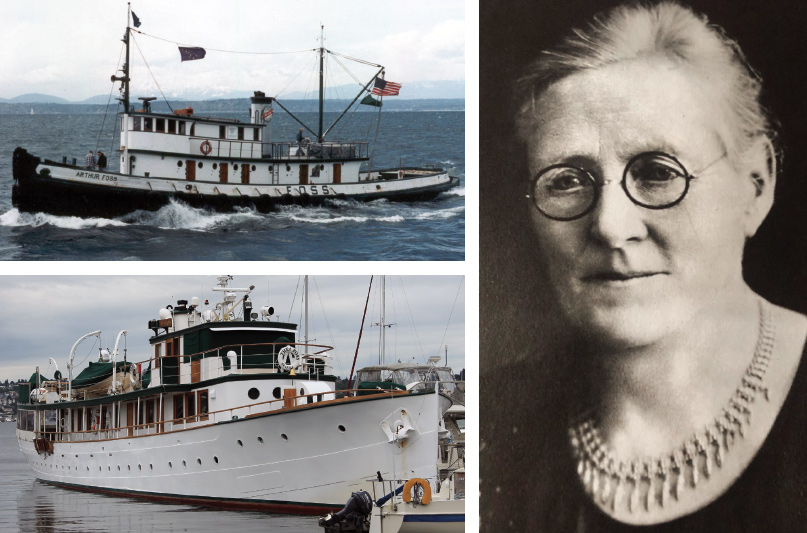
Left, Below: The M/V Thea Foss was originally built for actor John Barrymore. Foss Maritime purchased the yacht in 1950; guests have included King Olaf of Norway in 1975.
Right: Through strength of character, and being in the right place at the right time, Thea Foss soon launched one of the state’s oldest brands – Foss Launch & Tug, today’s Foss Maritime — and established a corporate culture that influences the company today. (Photo: Collection of Shannon Bauhofer)
When she spoke with Northwest Yachting, Bauhofer noted that the previous day two Foss tugs had escorted the USNS Mercy into Los Angeles to help those affected by the COVID-19 virus – a blend of maritime and humanitarian service that reflected her grandfather and great-grandmother’s values.
Noting that Foss Maritime was founded by a woman, Bauhofer pointed out that Saltchuk, which owns Foss Maritime and other transportation and distribution companies, is also female owned — sisters Denise Tabbutt and Nicole Engle are majority shareholders. “Thea would be very proud of that,” Bauhofer said.
Foss Maritime has also continued the tradition, started by Thea and Andrew, of naming a vessel after a Foss family member. Fourteen harbor tugs, nine ocean tugs and two offshore service vessels are so named. Bauhofer is particularly proud of one naming. Her granddaughter, who is now 6, is named Thea.


